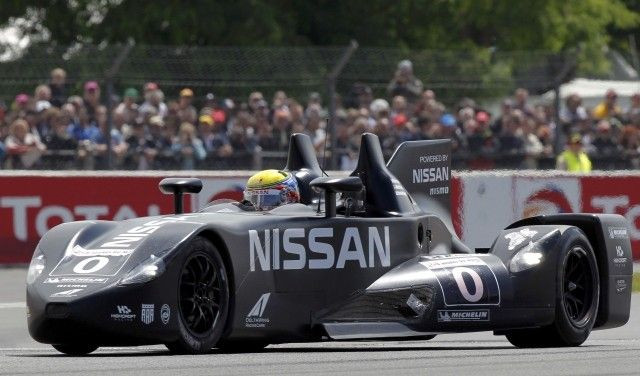'Satoshi Motoyama Is Our Hero!' Nissan DeltaWing Driver Real Hero Of Le Mans 2012 [VIDEO]

In probably the most dramatic moment in this weekend's 24 Heures Du Mans, the experimental and much-anticipated Nissan DeltaWing racing car, which promised to revolutionize the sport, was struck by LMP1-class Toyota racer, sending it flying into the tires and prematurely ending its day at the races. But the real story was just beginning when the car flew off the track on Saturday.
After the crash, DeltaWing driver Satoshi Motoyama spent 90 minutes by the side of the track trying to revive the damaged experiment enough to get it to the pits. Under the rules of Le Mans, the driver of a car cannot leave its immediate vicinity, and pit crews are not allowed onto the track. Video quickly began to circulate on the Internet showing Motoyama carefully disassembling his car with a pair of pliers and a screwdriver, trying to coax some life into the racer that Nissan and the DeltaWing team have called an answer in search of a question.
The event can only be termed tragic. The accident took place six hours and 1005 km (624 miles) into the endurance race. Moreover, the car was running on pace with highly competitive LMP2 cars and was on track to complete the race with half of the fuel consumption of the fastest LMP1 cars (fuel consumption is a major factor in determining the frequency of pit stops).
The DeltaWing was developed at a breakneck pace with only 107 days between its first drive and the race. The development teams and drivers poured their hearts and souls into it, and the most dedicated may have been Motoyama. In motorsport, it can be easy to forget the role of the driver when they are encased in a car moving at 200 mph, and Motoyama's struggle added a human element to the already captivating story of the DeltaWing.
Satoshi did everything right today; he made space to let the leaders go through, but Nakajima misjudged the situation, fellow Nissan DeltaWing driver Michael Krumm said. Once he was off Satohis did everything he could to get the Nissan DeltaWing back to the pits so the team could repair it. He was trying to take the engine cover off to get to the affected area but it wouldn't come off so he somehow managed to bend it back and climb in!
After an hour and half of effort, trying to get the DeltaWing to move, Motoyama finally had to come to terms with the fact that the steering and the left rear wheel were hopelessly damaged. Nissan DeltaWing mechanics had tried to offer whatever help and advice they could from outside of the racing paddock, but the only one that could save the car was Motoyama. When he left the track and the maimed car, he left to the applause of those who had gathered to watch and offer support. Some online commentators have said he left in tears, but this cannot be confirmed.
Either way, the crash ended any hope for the DeltaWing team. The Toyota racing team, including driver Kaz Nakajima, personally met with the Nissan and DeltaWing teams to apologize in a show of deep sportsmanship.
Satoshi showed us all what the Japanese working spirit is like. It's not in his character to give up, Krumm said. Character was fundamentally what the DeltaWing brought to Le Mans, both in style, innovation and the human story. During the lead-up to the race, the first six hours when it lived up to everyone's wildest dreams, and in the tragic crash and heroic attempt to salvage the race, the DeltaWing and its team demonstrated perfectly the human element of motorsport.
The accident occurred in a high-speed corner and the car hit a concrete wall. It was badly damaged. If I could get the car back to the pit, the team could fix the car and rejoin the race, so I tried everything I could, but since the power train damage was particularly serious, we couldn't revive the car, Motoyama said.
The DeltaWing racing website said in simple terms Monday, Satoshi Motoyama is our hero!
What people will remember most vividly about Le Mans 2012 is not the winners, but the strange looking experimental car that failed to finish the race and its driven pilot who put everything he could into saving it. Nissan racing will certainly remember. Even on the day of the crash when the team felt gutted by the event, General Manager for Nissan Europe Darren Cox said that the DeltaWing had been a success and would serve as a test bed for future innovations both on the road and track.
We came here and a lot of people were not sure that this car would work, but we have proven them wrong, Cox said.
DeltaWing racing said: Thank you Satoshi-san - your efforts made us so very proud.
© Copyright IBTimes 2024. All rights reserved.





















